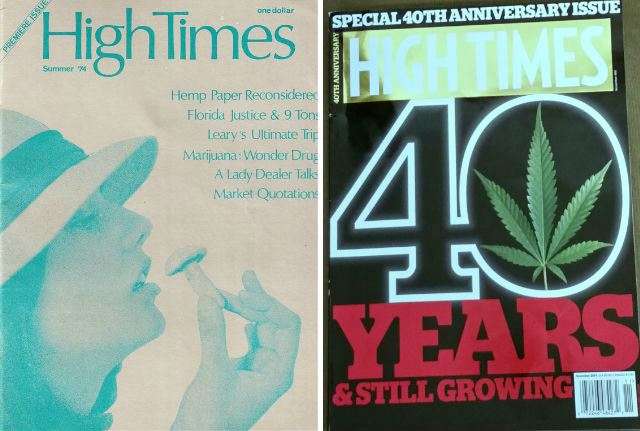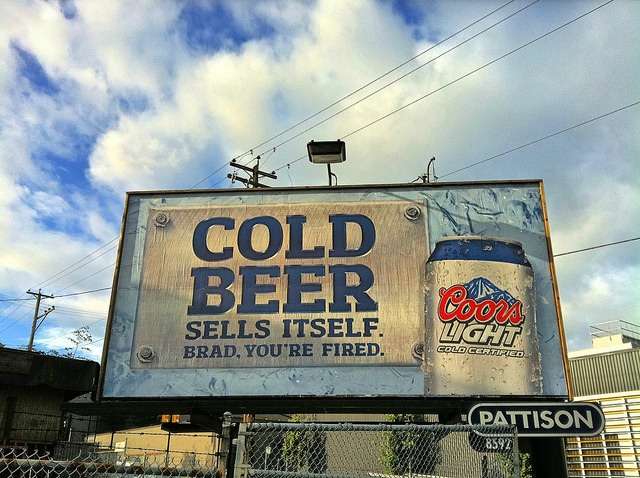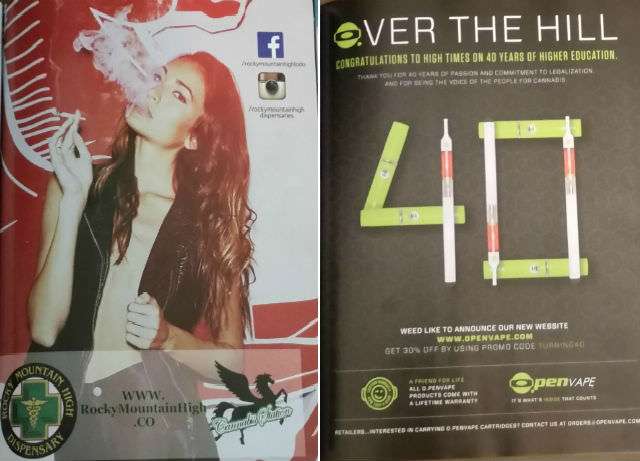High Times Challenges Colorado's Restrictions on Pot-Related Speech
Why wouldn't a marijuana business advertise in the flagship magazine of the cannabis counterculture?

High Times, the flagship publication of a cannabis counterculture that is rapidly going mainstream, celebrates its 40th anniversary this year. "We have been steadfast soldiers in this so-called War on Drugs," writes Editor in Chief Chris Simunek in a special issue that hits newsstands this week, "with truth as our sword and the First Amendment as our shield."
The First Amendment has protected High Times, and High Timeshas tried to return the favor. Last year the magazine was the lead plaintiff in a lawsuit challenging a Colorado law that required merchants to keep marijuana-focused publications behind the counter. The sponsor of that provision, a Republican representative from Colorado Springs named Bob Gardner, likened such periodicals to pornography. The law was so clearly unconstitutional that Colorado Attorney General John Suthers decided not to enforce it. Now High Times is seeking to overturn Colorado's onerous restrictions on marijuana advertising, which ostensibly are aimed at protecting impressionable children but probably have more to do with protecting disapproving adults.
Last year the state legislature instructed the Colorado Department of Revenue's Marijuana Enforcement Division (MED) to ban "mass-market campaigns that have a high likelihood of reaching minors." The MED therefore decided to prohibit "advertising that is visible to members of the public from any street, sidewalk, park or other public place." The one exception: "any fixed sign that is located on the same zone lot as a Retail Marijuana Establishment and that exists solely for the purpose of identifying the location of the Retail Marijuana Establishment." Among other things, this rule appears to mean that stores may not put up additional signs in their windows saying "Marijuana for Sale" or "Now Serving Recreational Customers."
"It's very, very restrictive," says Toni Fox , owner of Denver's 3D Cannabis Center. "I had a sandwich-board sign. All it said was 'Open,' and it had some green crosses on it. It was bolted to the ground. For three years [when 3D was a medical dispensary], that was acceptable. But now it is no longer acceptable. I had to remove it completely. I had these 'Open' flags on the deck. They made us take those down."
The MED's regulations, which apply to manufacturers of marijuana products as well as retailers, allow other kinds of ads only if the sponsor has "reliable evidence that no more than 30 percent of the audience…is reasonably expected to be under the age of 21." Strictly speaking, the 30-percent rule does not comply with the legislature's instruction to ban marijuana advertising with "a high likelihood of reaching minors." If, say, 25 percent of a magazine's readers or a TV show's viewers are younger than 21, advertising in that magazine or on that show still has a high likelihood of being seen by people in that age group. The rule is nevertheless burdensome and highly restrictive, prohibiting many ads that would be effective at reaching adult customers.
According to MED spokeswoman Natriece Bryant, cannabusinesses probably could show they are complying with the 30-percent rule by citing the survey data that publications and TV and radio stations often provide to advertisers. As for websites, which many dispensaries and manufacturers have, Bryant says "asking for the website visitor's age and birthdate is consistent with the model used by other industries such as liquor and tobacco, and would likely meet this standard."
Bryant says the MED adopted these rules because they are similar to "voluntary standards adopted by the alcohol industry." But there is a big legal difference between voluntary advertising codes and government censorship.
In a federal lawsuit filed at the end of June, High Times, joined by Pueblo's Pulpmagazine, the Colorado Press Association, Toni Fox's store, and Karmaceuticals, a medical dispensary in Lakewood, argue that Colorado's restrictions on marijuana advertising violate the First Amendment. The complaint, prepared by Denver attorney David Lane, also argues that the rules "irrationally single out Retail Marijuana Establishments for more stringent advertising restrictions than those regulating the alcohol industry, although the Colorado Constitution calls for the regulation of marijuana 'in a manner similar to alcohol.'" That phrase appears in Colorado's legalization initiative, Amendment 64, which is now part of the state constitution.

Despite the pretense of parity, Lane says, the state is clearly treating marijuana ads as more objectionable than ads for alcoholic beverages. "If marijuana is being regulated like alcohol, then take down all the alcohol billboards," he says. "They're not all that concerned about advertising Jim Beam whiskey and Coors beer. There's no real concern about how many minors are listening to those ads."
Lane also represented High Times in the fight against the law requiring bookstores and newsstands to hide marijuana magazines. The challenge to the advertising rules is not quite as straightforward.
On the face of it, Lane has a strong argument. In the 2001 case Lorillard Tobacco v. Reilly, the U.S. Supreme Court overturned a Massachusetts ban on tobacco billboards within 1,000 feet of a school or playground, concluding that the rule was not narrowly tailored to advance a substantial government interest, as required by the Court's test for restrictions on commercial speech. Although the Court deemed preventing underage tobacco consumption a substantial government interest and even accepted the dubious argument that advertising restrictions directly advance that goal, it said the 1,000-foot rule swept too broadly, barring outdoor tobacco advertising from "a substantial portion of Massachusetts' largest cities" and in some places amounting to "nearly a complete ban on the communication of truthful information about smokeless tobacco and cigars to adult consumers." Colorado's rules for marijuana ads, which also are officially aimed at shielding minors from messages about adult products, are decidedly more restrictive than the limits overturned in Lorillard, so it is hard to see how they could pass constitutional muster.
Then again, the Supreme Court has upheld outright bans on ads concerning illegal commercial activity. In the 1973 case Pittsburgh Press Co. v. Human Relations Commission, the Court approved a ban on employment ads that specify a preferred sex for applicants. "We have no doubt that a newspaper constitutionally could be forbidden to publish a want ad proposing a sale of narcotics or soliciting prostitutes," it said. Seven years later, in the landmark commercial speech case Central Hudson Gas & Electric v. Public Service Commission, the Court reiterated that principle, saying the First Amendment does not protect "commercial speech related to illegal activity."
UCLA law professor Eugene Volokh, a First Amendment specialist, says selling marijuana, even when permitted by state law, seems to fall under that exception. "I don't see how marijuana sales are lawful, given the federal prohibition, so I think advertising marijuana is not protected under commercial speech doctrine," Volokh says. "I realize that here the commercial speech restriction is imposed by the state, and the sales restriction is imposed by the federal government, but I don't think that would change the First Amendment analysis."
Lane argues that the relevant question is whether selling marijuana is legal in Colorado. "If it's legal somewhere, you can advertise it anywhere," he says. "Nevada casinos advertise throughout the country: Come to Nevada; gamble your ass off. The Mustang Ranch in Nevada could legally advertise their prostitution services throughout the United States, because it's legal in whatever county they're in. Same with marijuana in Colorado. We can advertise marijuana throughout the country because it's legal under state law in Colorado."
If the federal courts do not buy Lane's argument, he might have better luck in state court. The state constitution's free speech clause, as interpreted by the Colorado Supreme Court, provides even wider protection than the First Amendment. "If we get tossed out of federal court," Lane says, "we'd consider it." The Colorado Attorney General's Office declined to comment on the constitutionality of the regulations, citing the ongoing litigation.

It's not clear how Colorado's regulators plan to enforce the 30-percent rule, which requires cannabusinesses to determine the ages of the people likely to see any given ad. Did the MED notice, for example, that the 40th anniversary issue of High Timesincludes ads for Rocky Mountain High, a Colorado dispensary chain, and Open Vape, a Colorado company that makes vape pens with cannabis cartridges? I called both of those businesses to ask if they looked into the demographics of the magazine's readers but have not heard back yet. Dan Skye, editorial director at High Times, says "a great many of our readers are between the ages of 19 and 26," and "college readership is huge," which suggests that the under-21 segment might exceed the permissible percentage.
Lane says marijuana businesses should not have to worry about complying with the state's arbitrary rules. "It's not our clients' problem to figure out what the readership ofHigh Times magazine consists of," he says. "They have a product to sell. High Times is willing to publish that ad. That's as far as I'm willing to go. My clients don't have the wherewithal to figure out what the readership of High Times is or what a website's viewership is, and the First Amendment doesn't care about that either." To put it another way: How bizarre would it be, now that selling pot is finally recognized as a legitimate business, if marijuana merchants were not allowed to advertise in High Times?
This article originally appeared at Forbes.com.


Show Comments (15)